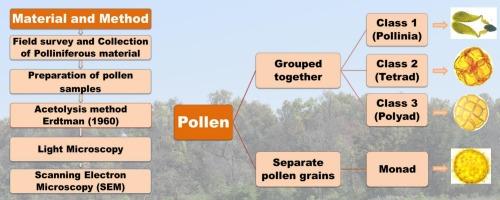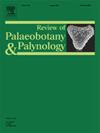印度拉贾吉国家公园花粉鉴定的图解钥匙
IF 1.7
3区 地球科学
Q2 PALEONTOLOGY
引用次数: 0
摘要
花粉粒的准确鉴定是古植物学、微生物学、空气生物学和法医学等多个领域的基础。本研究提出了一种鉴定Rajaji国家公园(RNP)花粉的综合图解密钥。该公园位于加尔瓦尔喜马拉雅山脉的Shivalik山麓,该地区以其丰富的植物多样性和重要的生态价值而闻名。从2021年到2024年进行了广泛的实地调查,收集了67科229属302种植物的传粉材料。按照标准的乙酰解方案制备花粉粒,随后使用光学显微镜(LM)和扫描电子显微镜(SEM)进行检查。根据花粉的散布单位和孔型,将其划分为24个不同的花粉类。开发了一个图解的花粉识别键,包括一个将花粉区分为不同类别的通用键,然后是每个类别的单独键。该钥匙可作为喜马拉雅山麓孢粉学研究的基础参考。这项工作解决了区域孢粉学研究中的一个关键空白,并有助于加强印度的花粉数据库。本文章由计算机程序翻译,如有差异,请以英文原文为准。

An illustrated key for the identification of pollen from Rajaji National Park, India
Accurate identification of pollen grains is fundamental to diverse fields such as palaeobotany, melissopalynology, aerobiology, and forensic science. This study presents a comprehensive illustrated key for the identification of pollen from Rajaji National Park (RNP). The park is situated in the Shivalik foothills of the Garhwal Himalaya, a region renowned for its rich floral diversity and significant ecological value. Extensive field surveys were conducted from 2021 to 2024, and polliniferous material from 302 plant species, representing 229 genera and 67 families, was collected. Pollen grains were prepared following the standard acetolysis protocol and subsequently examined using both light microscopy (LM) and scanning electron microscopy (SEM). Based on dispersal units and aperture type, the taxa were classified into 24 distinct pollen classes. An illustrated pollen identification key was developed, comprising a general key to differentiate pollen into distinct classes, followed by separate keys for each class. This key serves as a foundational reference for palynological research in Himalayan foothills. The work addresses a critical gap in regional palynological studies and contributes to strengthening pollen databases in India.
求助全文
通过发布文献求助,成功后即可免费获取论文全文。
去求助
来源期刊
CiteScore
3.50
自引率
21.10%
发文量
149
审稿时长
6 months
期刊介绍:
The Review of Palaeobotany and Palynology is an international journal for articles in all fields of palaeobotany and palynology dealing with all groups, ranging from marine palynomorphs to higher land plants. Original contributions and comprehensive review papers should appeal to an international audience. Typical topics include but are not restricted to systematics, evolution, palaeobiology, palaeoecology, biostratigraphy, biochronology, palaeoclimatology, paleogeography, taphonomy, palaeoenvironmental reconstructions, vegetation history, and practical applications of palaeobotany and palynology, e.g. in coal and petroleum geology and archaeology. The journal especially encourages the publication of articles in which palaeobotany and palynology are applied for solving fundamental geological and biological problems as well as innovative and interdisciplinary approaches.

 求助内容:
求助内容: 应助结果提醒方式:
应助结果提醒方式:


